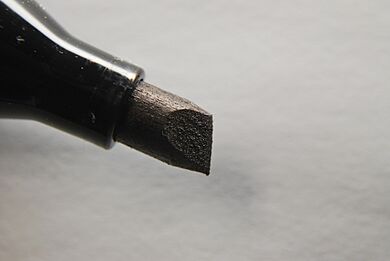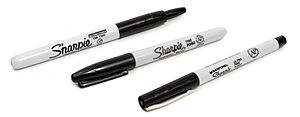Permanent marker facts for kids
A permanent marker is a special type of marker pen. It's designed to write on many different surfaces. The ink stays on objects for a long time. That's why it's called "permanent" or "indelible."
Contents
What Makes a Marker Permanent?
The ink in a permanent marker is made of a few key things. These include a special liquid called a solvent, a sticky material called a resin, and a colorant that gives it its color. This mix makes the ink resistant to water. It can write on almost anything, from paper to metal to stone.
Permanent markers come in many sizes and shapes. You can find them with very fine tips for small details or wide tips for big, bold lines. Some tips are shaped like a chisel, while others are round like a bullet. They also come in many colors, including shiny metallic ones!
Most permanent markers use alcohol-based liquids. Other types, called paint markers, have different liquids that dry quickly. The permanent marker was invented in 1952 by Sidney Rosenthal.
How Are Permanent Markers Used?
Everyday Uses
Permanent markers are used for writing on many things. These include metals, plastics, ceramics, wood, stone, and cardboard. However, the mark might not be truly permanent on some smooth surfaces. For example, you can often wipe permanent marker ink off some plastics, like polypropylene, with a little rubbing.
When used on regular paper, the ink often soaks through. This means you can see the mark on the other side of the paper.
Using Markers in Science
Scientists sometimes use permanent markers in a cool way. They can use them to label tiny microscopy slides. They can also use them to do something called a "negative stain" on tiny bacteria. This means the marker ink stains the background, but not the bacteria themselves. This makes the bacteria stand out as lighter shapes against the darker, stained background. It helps scientists see them better!
How to Remove Permanent Marker Marks
Even though they are called "permanent," these markers can often be removed. This is especially true on hard, smooth surfaces. The ink forms a layer on top of these surfaces, rather than soaking in.
You can often remove permanent marker marks using:
- High-pressure cleaning: Like a strong spray of water.
- Special cleaners: Things like paint thinners or other strong liquids called organic solvents. These include acetone (found in some nail polish removers) or isopropyl alcohol (rubbing alcohol). When cleaning indoors, it's safer to use things like rubbing alcohol or ethanol because their fumes are less harmful. Always make sure there is good air flow when using any strong cleaners.
- Nail polish remover: Many brands of nail polish remover that don't contain acetone (but instead have ethyl acetate) can easily wipe off marker marks.
- Dry erase markers: This is a neat trick! If you draw over a permanent marker mark on a smooth surface (like a whiteboard) with a dry erase marker, you can often wipe both marks away. This is because dry erase markers also contain a special liquid that helps dissolve the permanent ink.
Rules About Permanent Markers
Because permanent markers can be used for things like vandalism (drawing on public property without permission), some places have rules about them. For example, in some cities and states, it might be against the law for people under a certain age (like 20) to have permanent markers in public. There might also be rules about selling them to young people. These laws are in place to help prevent misuse.
See also
- List of pen types, brands and companies
- Inhalants




